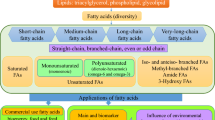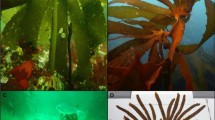Abstract
Fungi had become the main resource of polyunsaturated fatty acids, especially linoleic acid. The research studied the effects and mechanism of selenium on polyunsaturated fatty acids of Diasporangium jonesianum. The results showed that selenium could significantly increase the yields of linoleic acid. In contrast, the growth and γ-linolenic acid yield of D. jonesianum was decreased under selenium treatments. Δ6-Fatty acid desaturase gene of D. jonesianum was investigated in this research. Sequence analysis indicated that this cDNA sequence encoded 235 amino acids. The conserved region of Δ6-fatty acid desaturase included three conserved histidine-rich domain, hydropathy profile, and was rich in disulfide bonds. This study showed that selenium may in discriminatively substitute S and incorporate selenium-amino acids into the desaturase that the conformation of enzyme active sites was impacted which leaded to the inhibition of the convert of linoleic acid to γ-linolenic acid and the over accumulation of linoleic acid. Selenium might enhance the fatty acid contents of fungi through influencing the desaturase structure.







Similar content being viewed by others
References
Lio, J. Y., & Wang, T. (2013). Applied Biochemistry and Biotechnology, 169, 595–611.
Kuhnt, K., Degen, C., Jaudszus, A., & Jahreis, G. (2012). European Journal of Lipid Science and Technology, 114, 153–160.
Morales, P., Ferreira, I. C. F. R., Carvalho, A. M., Fernandez-Ruiz, V., Sanchez-Mata, M. C., Camara, M., Morales, R., & Tardio, J. (2013). European Journal of Lipid Science and Technology, 115, 176–185.
Calder, P.C., & Burdge, G.C. (2004). The Oily Press, 1–36.
Lu, H., Li, J. N., Chai, Y. R., Chai, Y. R., & Zhang, X. K. (2009). Molecular Biology Reports, 36, 2291–2297.
Laoteng, K., Mannontarat, R., Tanticharoen, M., & Cheevadhanarak, H. S. (2000). Biochemical and Biophysical Research Communications, 279, 17–22.
Michinaka, Y., Aki, T., Shimauchi, T., Nakajima, T., Kawamoto, S., Shiqeta, S., Suzuki, O., & Ono, K. (2003). Applied Microbiology and Biotechnology, 62, 362–368.
Dong, J. Z., Lei, C., Ai, X. R., & Wang, Y. (2012). Applied Biochemistry and Biotechnology, 166, 1215–1224.
Glogowski, R., Czauderna, M., Rozbicka-Wieczorek, A., & Krajewska, K. A. (2013). European Journal of Lipid Science and Technology, 115, 170–175.
Zhao, M., Dai, C. C., Guan, X. Y., & Tao, J. (2009). Enzyme and Microbial Technology, 45, 419–425.
Riley, M. B., Collins, I. J., Richardson, Y. T., & Stutzenberger, F. J. (2000). Mycologia, 92, 301–304.
Blau, K., & Darbre, A. (1993). Wiley, 11–29.
Chomczynski, P., & Sacchi, N. (1987). Analytical Biochemistry, 162, 156–159.
Thompson, J. D., Gibson, T. J., Plewniak, F., Jeanmougin, F., & Higgins, D. G. (1997). Nucleic Acids Research, 25, 4876–4882.
Moller, S., Croning, M. D., & Apweiler, R. (2001). Bioinformatics, 17, 646–653.
Sperling, P., Zahringer, U., & Heinz, E. (1998). Journal of Biological Chemistry, 273, 28590–28596.
Sayanova, O., Beaudoin, F., Libisch, B., Castel, A., Shewry, R. R., & Napier, J. A. (2001). Journal of Experimental Botany, 52, 1581–1585.
Shanklin, J., Whittle, E., & Fox, B. G. (1994). Biochemistry, 33, 12787–12794.
Fukuyama, K., Ueki, N., Nakamura, H., Tsukihara, T., & Matsubara, H. (1995). Journal of Biochemistry, 117, 1017–1023.
Huber, R., Scholze, H., Paques, E. P., & Deisenhofer, J. (1980). Hoppe-Seylers Zeitschrift Fur Physiologische Chemie, 361, 1389–1399.
Vangronsveld, J., & Clijsters, H. (1994). Weinheim, 34, 149–177.
Nango, J. L., Czerucka, D., Menguy, F., & Rampal, P. (1989). Biological Trace Element Research, 20, 31–43.
Dodge, M. L., Wander, R. C., Butler, J. A., Du, S. H., Thomson, C. D., & Whanger, P. D. (1999). Journal of Trace Elements in Experimental Medicine, 12, 37–44.
Brown, T. A., & Shrift, A. (1982). Biological Reviews, 57, 59–84.
Banuelos, G. S., Terry, N., Leduc, D. L., Pilon-Smits, E. A. H., & Mackey, B. (2005). Environmental Science & Technology, 39, 1771–1777.
Sanchez, G. M., Garcia, E. A., Izquierdo, J. A., & Del, L. M. (2008). Cell Biology and Toxicology, 24, 321–329.
Acknowledgments
This research received financial support from a project funded by the Priority Academic Program Development (PAPD) of Jiangsu Higher Education Institutions, the National Key Technology Research and Development Program of China (2006BAD27B09), and the Program of Jiangsu Key Laboratory of Marine Biotechnology (2007HS012).
Author information
Authors and Affiliations
Corresponding author
Rights and permissions
About this article
Cite this article
Jia, Y., Guan, XY. & Dai, CC. The Effects of Selenium on Polyunsaturated Fatty Acids of Diasporangium jonesianum . Appl Biochem Biotechnol 172, 561–569 (2014). https://doi.org/10.1007/s12010-013-0477-7
Received:
Accepted:
Published:
Issue Date:
DOI: https://doi.org/10.1007/s12010-013-0477-7




